Homemade Chicken Bones Stock Recipe
It’s so easy to make delicious chicken stock using Chicken Bones and leftovers. Homemade chicken stock is rich in flavor, packed with nutrients, and will save you money.
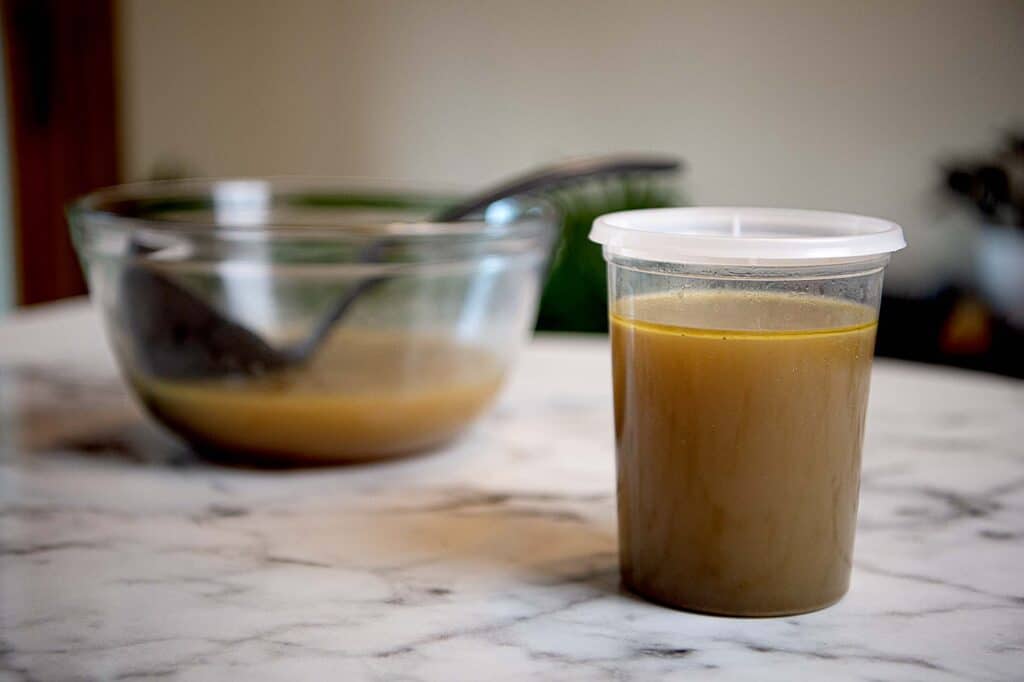
A rich stock is the sneaky hero of so many tasty soups, gravies, stews, casseroles, and more. It adds depth of flavor and richness to any dish it touches.
Lots of stock recipes rely on a fresh whole chicken, fresh vegetables, etc. Don’t get me wrong- this is great.
But there is a far easier, cheaper, and equally tasty way. Follow this chicken stock recipe using just chicken and vegetable scraps!
SIGN UP FOR OUR MONTHLY NEWSLETTER
Have delicious homemade chicken stock on hand is a pro move because it is flexible to add to so many different recipes. I recommend making your stock from scraps because it:
- Reduces food waste. Instead of tossing those parts of a chicken or ends of vegetables, freeze it and use it later.
- It’s super delicious. Stock from scratch is incredibly tasty, way more so than the store bought stuff.
- It saves you money. Store bought stock can get expensive, especially if it’s organic. Plus, using kitchen scraps is a great way to get your money’s worth out of the food you’ve already bought.
When it’s a laze-around-the-house kind of day, bust out a big soup pot, fill it with scraps and water, and let it simmer away. You’re well on your way to having a stash of savory chicken stock.
Chicken stock vs broth
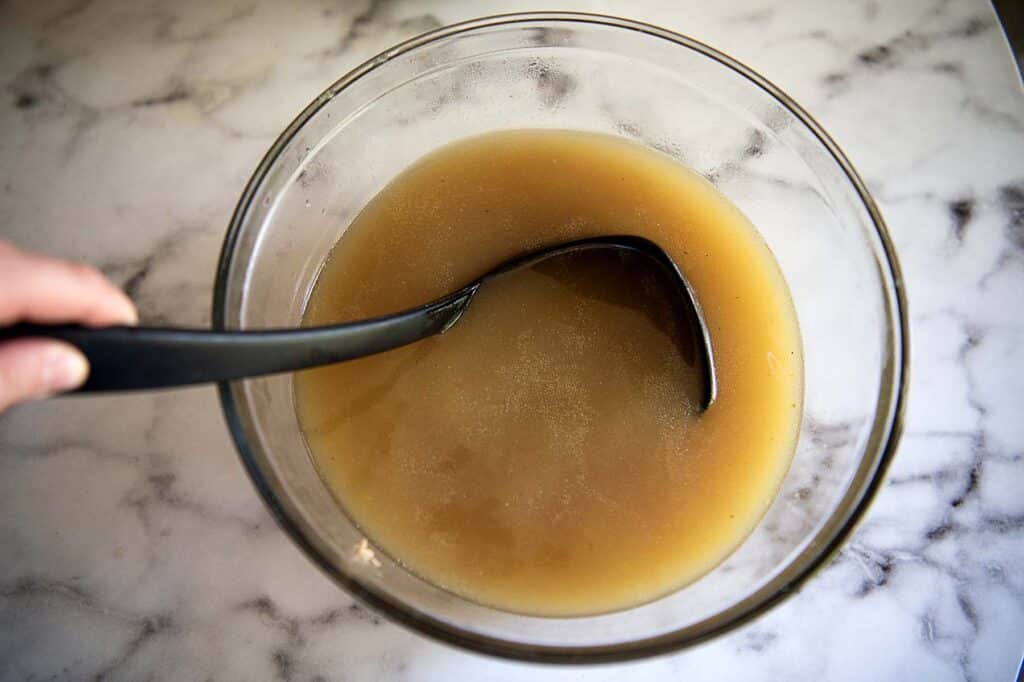
It’s understandable to think that stock and broth are the same thing. They’re both a savory liquid made from scraps and bones to add to soups, stews, and more. But there are a few big differences.
The main difference between the two is that stock is made primarily from bones, and broth is made from the flesh. Both are supported by aromatic vegetables, but stock always involves bones.
A good stock has a thicker consistency than broth and will slightly gel when chilled. Bones contain natural collagen and gelatin which is why stock is great for gravies and sauces.
Broths have a thinner and more watery texture making them perfect for soup bases.
Another big difference is the seasoning. Add and cook stock in a wide variety of gravies, stews, soups, and more to add a layer of richness- not to overpower. Leaving the stock under seasoned is intentional so it can be used flexibly.
On the other hand, broth is seasoned. It can be added to other recipes the same way a stock can, but can also be enjoyed on its own.
What kind of scraps you should freeze for stock
I like to keep several gallon sized plastic bags in my freezer to gradually fill up with vegetable and chicken scraps.
When I roast a whole chicken or buy a rotisserie chicken, I always save the carcass. Free flavor baby! Simply stuff it in a plastic airtight bag or container and put it in the freezer.
Chicken bones and chicken parts have nutrients, collagen, and gelatin- all essential to the best chicken stock recipe.
Bones from chicken legs, wings, thighs, and bone-in breasts are also great to save. You can discard any super large pieces of skin. The skin would mostly add fat, unlike the bones which add delicious collagen and gelatin.
Save the ends of carrots, celery, and onions- the French mirepoix. These three aromatic vegetables are the foundation of so much of Western cooking and a good stock.
When I buy a bag of carrots or celery and don’t think I will use it all before it goes bad, I will preemptively take out a few stalks and carrots. I snap them in half and put them in my freezer scrap bag. (Because really, who eats a whole bag of celery?)
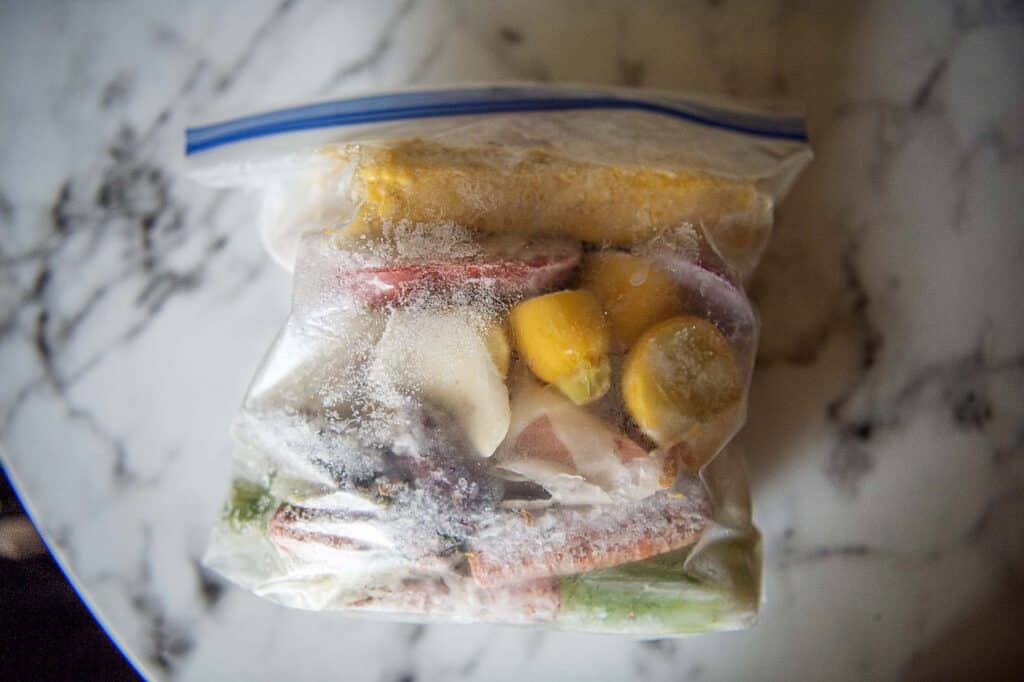
Those three aren’t the only vegetable ends I’m saving. I also add the ends of squash, peppers, corn cobs, mushrooms, tomatoes, leeks, potato peels, herbs, garlic skin, onion skins, and more. All add nutritional value and depth of flavor to your stock.
Vegetables I avoid adding to my scrap bag include radish, lettuce, cucumber, hot chilies, cabbage, and brussel sprouts.
You can keep your meat and vegetable scraps in the same bag or separate. I like to keep them separate in case I want to make a vegetable broth for vegan or vegetarian eaters.
How to make chicken bones stock
Let’s break down this chicken stock concentrate recipe. The first step is to get in the habit of saving your veggie scraps and chicken pieces.
When I’ve filled up one freezer bag of vegetable scraps and have another bag with a chicken carcass, that’s when I know I’m ready to make some stock.
Remove your scrap bags from the freezer and dump into your large pot. Make sure you have a good mix of garlic, carrot, onion, and celery. If you are lacking any of those, throw in some fresh carrot, garlic, onion, or celery.
For example, last time I made stock my vegetable bag was mostly onion ends and skins, with only a little carrot and celery. So I threw in a couple fresh stalks of celery, carrot, and about a half head of garlic.
With your chicken parts and vegetables in the pot, fill with water. Put in just enough water to cover everything, but make sure you still have 2 – 3 inches from the top so it doesn’t boil over. If you cover the contents with water but are very close to the top, you might have too many scraps.

Throw in peppercorns, a little salt, and bay leaves. Remember, don’t over season. (The only time I will say to under season something).
Bring to a rolling simmer over medium high heat. Reduce the heat to low, cover, and let simmer for about 3 – 6 hours.
Check a couple times throughout to skim any scum or access fat from the top. Use a spoon and discard.
After 3 – 6 hours, remove the cover and let it simmer for another 30 minutes. This will help reduce the stock some. Then, remove from heat and allow to cool.
Next, it’s time to strain the stock. Use another large pot or bowl and pour the stock into it, running it through a fine mesh strainer. Allow the solids to cool some and then discard.
What is chicken base
Chicken base is a highly concentrated thick compound made up from blended chicken parts and vegetables. Use this in place of chicken stock to make stews, soups, gravies, etc.
Chicken base is much thicker than chicken stock and can be a cube or paste form.
How long does chicken stock last in the fridge
Chicken stock lasts about 4 – 5 days in the refrigerator. When making chicken stock, it is a good practice to refrigerate the amount you will use within a few days and freeze the rest. Chicken stock holds up great in the freeze.
Recipes with chicken stock
Chicken stock is great to have in your freezer because it can be used in so many different kinds of recipes. Use a stock for your favorite stew or soup to boost richness, like our Savory Butternut Squash Soup recipe.
Take your grains like wild rice, farro, white rice, quinoa, and risotto over the top by cooking them in stock. Use in a ratatouille, your favorite curry, jambalaya, or a chicken chili.
A couple of weeks before holidays like Thanksgiving, Christmas, and New Year’s, I like to make a batch of chicken bones stock and freeze it.
I know those holidays lend to savory dishes like cornbread dressing, gravy, green bean casserole, and more. Adding homemade stock is my little secret ingredient to make them even more delicious.
Homemade Chicken Bones Stock Recipe
Equipment
- 1 fine mesh strainer
- 1 Stockpot or large pot
Ingredients
- Chicken carcass and/or bones
- Onion scraps, ends, and skins
- Carrot scraps, ends and skins
- Celery scraps, ends and leaves
- Garlic scraps and skins
- Parsley scraps, stems and leaves
- 2 bay leaves
- 1 tb whole peppercorns
- 1 tb kosher salt
- 12 cups water or more enough to cover ingredients
Optional
- other vegetable scraps like squash, tomato, leeks, corn, mushrooms, etc.
Recipe Instructions
- [Overtime save carrot, onion, celery, garlic, parsley, and other vegetables in a gallon sized bag in your freezer. Save chicken bones, parts, and carcass.]
Make Stock
- Place chicken bones/carcass and vegetable scraps, bay leaves, peppercorns, and salt in a large stock pot. Fill and cover with water, leaving about 2 – 3 inches at the top.
- Bring to a rolling simmer over medium high heat. Reduce heat to low, cover, and simmer for 3 – 6 hours. Check midway through to remove any scum that rises to the surface.
- Remove cover and allow to simmer for another 30 minutes. Remove from heat and allow to cool slightly. Use a fine mesh strainer to strain off the solids. Discard the solids and allow to cool.
- Transfer to jars or storage containers.



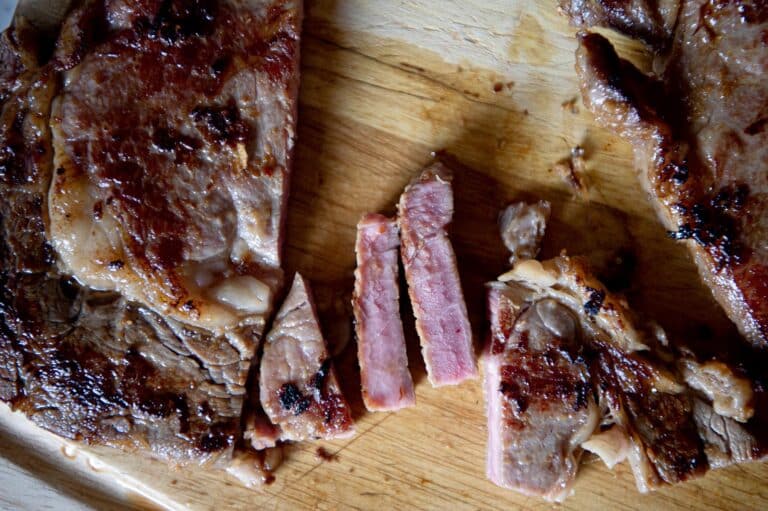


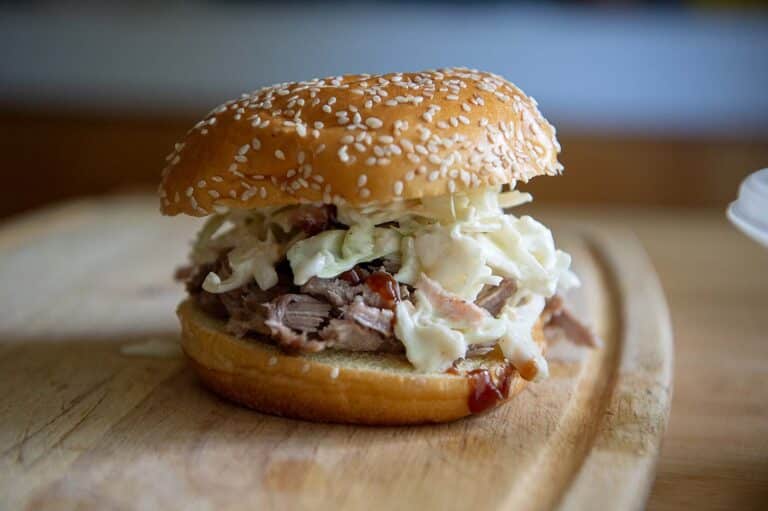

Disclosure: This post may contain affiliate links, meaning we receive a commission if you make a purchase using these links, at no extra cost to you.